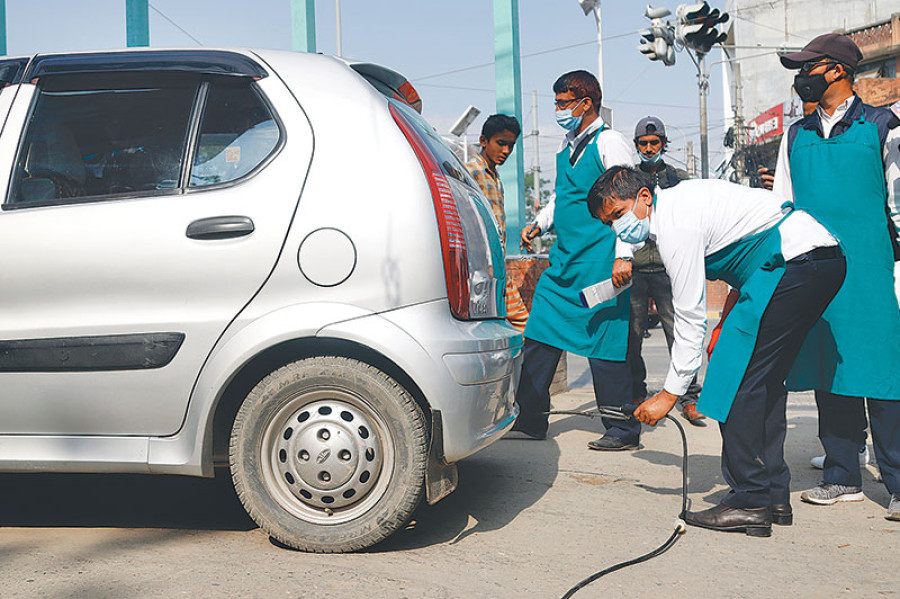Kathmandu
KMC to start random emission tests from next week
Besides four-wheelers, motorcycles and scooters will also be tested. First-time offenders will face a fine of up to Rs1,000, according to officials.
Arjun Poudel
The Kathmandu Metropolitan City has announced that it will start random on-the-spot emission testing of vehicles on the road beginning next week.
The move of the city office comes amid deteriorating air quality in Kathmandu Valley.
“We have provided necessary training to two mechanical engineers, who will be deployed for emission testing,” said Jagatman Shrestha, traffic expert adviser at the metropolis. “We have also coordinated with the environment department of the federal government, traffic police, and the department of transport management to start these tests.”
The city office has purchased two smoke meters (a portable device for testing vehicle emissions)—one for diesel vehicles and the other for petrol vehicles—to carry out emission testing. Officials say, for the first time, motorcycles and scooters will also be tested.
Though vehicle emission testing is mainly the responsibility of federal government agencies, the constitution also mandates local governments to take measures to reduce pollution, officials say.
The metropolis has developed pollution control guidelines as per the KMC Environment and Natural Resources Protection Act-2021.
Officials say these random tests will be conducted on vehicles that have passed emission testing from the department of transport management and received green stickers, as all four-wheelers on the road typically do. However, some may still emit black smoke for various reasons, including lack of timely servicing and maintenance.
Many automobile owners only service their vehicles ahead of the annual pollution testing.
“We will not issue green stickers to vehicles but check emission levels,” said Shrestha. “If we find vehicles emitting pollutants more than permissible levels, we will slap a fine.”
According to the officials, Rs1,000 will be fined for polluting vehicles for the first time.
Random vehicle testing is among the measures the city office is taking to tackle air pollution.
The municipal environment department has also started monitoring the city’s air quality independently. For that, the city office has installed portable devices in various locations.
“We have already installed portable air quality monitoring devices in 16 locations within the metropolis and are preparing to install three more,” said Sarita Rai, chief of the department. “We have also launched a drive to make people aware of air pollution.”
Nepal’s air quality reaches hazardous levels several times a year, and the capital city often becomes the world’s most polluted metropolis.
According to IQ AirVisual, a Swiss group that collects air quality data from around the world, Kathmandu’s PM2.5 levels reached 197 micrograms per cubic metre (μg/m3) on Friday afternoon.
PM2.5 refers to particulate matter (solid or liquid droplets) in the air that is less than 2.5 micrometres in diameter. It is among the most dangerous pollutants that can get past the nose and throat to penetrate the lungs and get into the bloodstream. PM2.5 particles are small and likely to stay suspended in the air for long, increasing the chances of people inhaling them.
As per the Environmental Protection Agency’s air quality index, when air quality reaches 151-200, it is considered unhealthy; everyone may experience problems, with sensitive groups feeling more severe effects.
Major hospitals report a spike in respiratory problems due to the impact of toxic air and dust.
Meanwhile, the city office said it had installed push-button traffic lights in 36 locations for the ease of pedestrians.
“We are working to bring those devices into operation soon,” said Shrestha, traffic adviser of the metropolis. “Pedestrians can push the button to stop traffic and cross the road safely.”
Push-button devices are installed at traffic intersections to allow pedestrians to request stop road traffic, so that they can cross the road without fear.




 9.12°C Kathmandu
9.12°C Kathmandu










%20(1).jpg&w=300&height=200)

